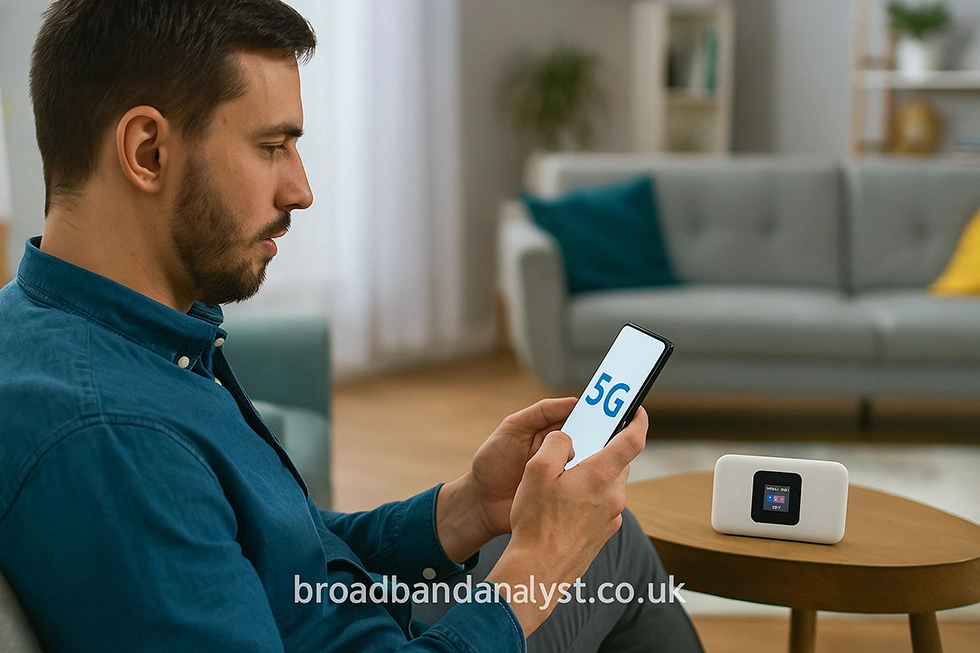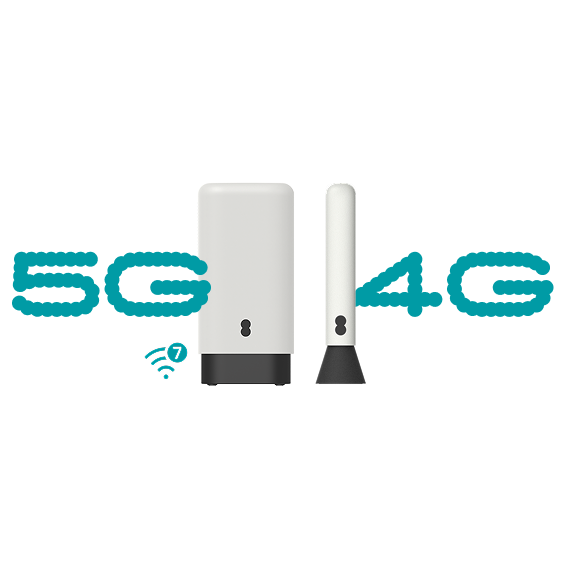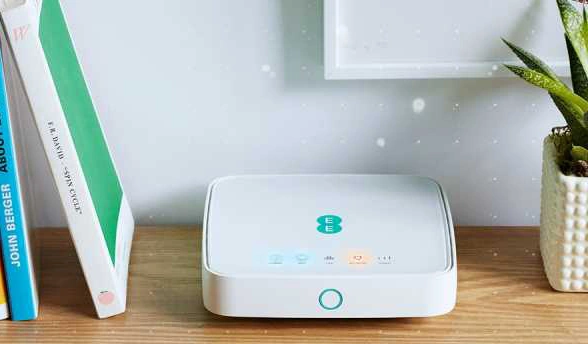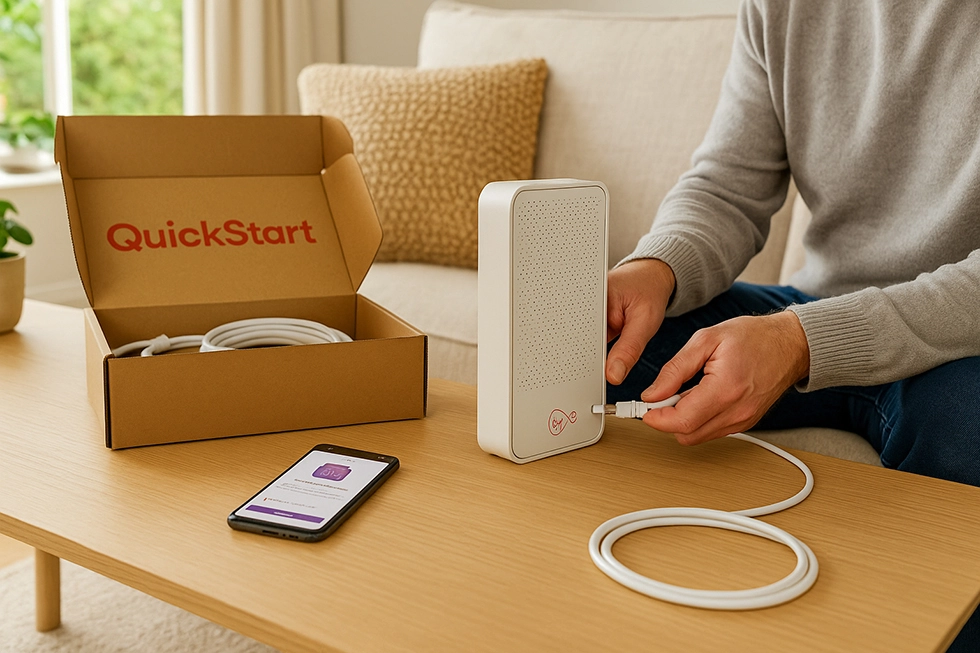Mobile Broadband Explained – 4G & 5G Networks, Providers and UK Deals
Mobile broadband in the UK has grown up. 5G now covers large towns and cities, and 4G remains wide-reaching across most places people live and work. Plug-and-play routers, pocket-sized hotspots, and simple data SIMs mean you can get online quickly, without waiting for an engineer or a phone line.
This guide explains what mobile broadband is, how it works, the hardware options, who provides it, and how to pick the right deal for your home or on-the-go use.

What is mobile broadband?
Mobile broadband is internet access delivered over a mobile network instead of a fixed line. Your device connects to 4G or 5G from the nearest mast using a data SIM. A mobile router or MiFi hotspot then creates Wi-Fi for your phones, laptops, TVs and smart devices, or you can plug in via Ethernet on some routers.
There’s no need for a phone line. No street-level install. In many cases you insert the SIM, power on the router, and you’re online in a few minutes.
Mobile broadband is useful for:
- Homes waiting for a fixed connection or moving frequently
- Renters who can’t drill or install new cabling
- Students and shared houses.
- Rural properties where fibre availability is limited
- Backup connectivity for home working
How mobile broadband works
A mast broadcasts 4G or 5G signal across an area. Your device—dongle, MiFi, phone, or a mains-powered 4G/5G router—contains a modem and the right antennae to receive that signal. The modem converts the radio signal to data. A router then shares that data as Wi-Fi or through Ethernet ports.
5G introduces two important improvements over 4G:
- Throughput: much higher download and upload capacity under good radio conditions
- Latency: more responsive connections, so actions feel quicker in video calls, cloud apps and online games
You’ll often see two 5G terms:
- Non-Standalone (NSA): 5G data rides alongside 4G signalling. This is the most common mode today.
- Standalone (SA): full 5G core with lower latency potential and more advanced features. It’s expanding across the UK.
Mobile broadband vs Wi-Fi vs fibre
Wi-Fi is not the internet connection. Wi-Fi is the short-range wireless signal inside your home created by your router. The internet connection that feeds that Wi-Fi can be mobile broadband, fibre-to-the-premises (FTTP), fibre-to-the-cabinet (FTTC), cable, or something else.
Is mobile broadband as good as fibre? If you have strong 5G and a decent router, typical downloads can easily pass 100–200+ Mbps with responsive performance. For many households that’s more than enough for streaming, cloud backup, and working from home. FTTP still tends to be more consistent at peak times and usually offers faster uploads, which matters to creators, frequent large file transfers, and some gamers. But in the right location, 5G home broadband can replace a fixed line comfortably.
Dongles, MiFi, and mobile broadband routers
You can choose from several types of mobile broadband devices, depending on how you want to get online.
USB dongle
A small USB modem that plugs into a laptop. It’s designed for one device at a time. Some modern dongles can create a tiny hotspot, but they’re best thought of as single-device access for people who travel with a laptop.

Good for: solo commuters, field workers, quick access where you can’t or don’t want to tether your phone.
MiFi
A pocket-sized, battery-powered Wi-Fi hotspot with a SIM inside. It shares 4G or 5G over Wi-Fi to multiple devices at once. Because it’s battery-powered, it’s highly portable. Range and throughput are usually lower than a mains-powered router.

Good for: students, caravans, short lets, contractors, and anyone who wants Wi-Fi on the move without using their phone’s hotspot all day.
Do MiFi routers require a SIM? Yes—a data-only SIM (PAYG or monthly plan).
4G/5G mobile broadband router
A mains-powered router with a 4G/5G modem and better antennae than a MiFi. It looks like a home broadband router, often with Ethernet ports, dual-band or tri-band Wi-Fi, and sometimes external antenna ports. You place it by a window or in the strongest signal spot and it powers your whole home network.

Good for: replacing home broadband, failover for home workers, small businesses, and anyone who wants stronger Wi-Fi and steadier throughput than a pocket hotspot can provide.
Which is better, a router or a MiFi? For home use, a mains-powered router is the better bet—higher throughput, better Wi-Fi coverage, and Ethernet ports. Choose MiFi for travel and portability.
Mobile broadband and 5G home broadband Providers in the UK
The leading UK networks and a few alternatives:
Three
- What you get: unlimited home plans, plug-in 5G hub, straightforward setup
- Best for: renters, students, households that want an easy fibre alternative
- Before you buy: check the return period and confirm indoor 5G strength in the rooms you’ll actually use
Three offers unlimited 5G Home plans with a plug-and-play hub on 1-month and 24-month terms. It’s often among the simplest ways to try 5G at home. Hardware frequently includes a Zyxel or ZTE 5G hub with dual-band Wi-Fi and Ethernet ports. Where 5G is strong, many households see triple-digit downloads and low-double-digit uploads.
What stands out: straightforward unlimited data options and easy setup. Check return windows so you can test signal at home.
Vodafone
- What you get: GigaCube 5G/4G router for home, dongles, MiFi and data SIMs
- Best for: families who want one device to serve the whole home and an operator-supplied router
- Before you buy: check 5G availability and whether you need a 1- or 24-month term
Vodafone offers the GigaCube 5G/4G router for home use, plus data SIMs and dongles. GigaCube supports many devices and has Ethernet for wired gear. Speeds depend on local signal quality; in good 5G areas, typical downloads are easily in the 100–200 Mbps range with faster peaks.
What stands out: broad device range (dongle, MiFi, GigaCube), decent router hardware, and flexible data SIMs.
EE
- What you get: mobile hotspots, data SIMs, and selected 5G home availability
- Best for: road warriors who value coverage and people who already use EE mobile
- Before you buy: verify 5G coverage at your address for a home replacement
EE is strong on mobile coverage and offers mobile broadband devices and data SIMs. 5G home availability varies by area and stock. It’s worth checking if EE has strong outdoor 5G where you live; if yes, performance can be excellent with a quality router.
What stands out: network reach and 5G footprint, especially for road warriors who value coverage.
O2
- What you get: data SIMs, device options change from time to time
- Best for: households already on O2 who prefer to keep everything with one provider
- Before you buy: confirm indoor signal; consider whether a third-party 5G router will serve you better than a pocket hotspot
O2 provides data SIMs and mobile broadband options. It’s now part of Virgin Media O2, but the fixed Virgin Media cable/fibre network is separate. Use O2 if you already have strong mobile signal indoors and want a simple SIM-led setup.
What stands out: bundle potential if your household already uses O2 mobile; check device and plan options at time of order.
National Broadband
- What you get: network matching across operators, strong routers, optional external antenna advice
- Best for: rural locations or tricky indoor signal where a tailored setup helps
- Before you buy: ask about trial terms, antenna options and any install support
Some providers resell multi-network 5G home broadband with a choice of routers and optional external antenna setups. This can help in fringe areas where one network covers your property better than others.
What stands out: one stop for router, install advice, and network matching—useful in rural or tricky indoor coverage spots.
Coverage, speeds and latency
Mobile is radio. Performance changes with signal strength, distance to the mast, the spectrum band in use, and how busy the cell is.
- 5G typically delivers much higher downloads and more responsive performance than 4G, especially on mid-band spectrum.
- 4G can still be perfectly usable for many homes, but it varies more at peak times.
- Indoor signal matters. Walls, foil insulation, and double glazing can reduce signal quality.
- Latency on strong 5G can be low enough for smooth video calls and casual gaming; FTTP tends to be more consistent.
A practical rule of thumb: if you can place a 5G router where your phone shows strong 5G and good speed tests throughout the day, mobile broadband is very likely to deliver a reliable experience for streaming, cloud work and everyday use.
Unlimited data, fair use, and traffic management
Unlimited mobile broadband plans exist, including 5G home packages. Some networks apply traffic management during busy times or reserve the right to investigate very high usage. Roaming is usually capped on data-only plans, so do not assume your UK plan is unlimited abroad.
Read the plan details before you order, and if a return window is available, use it to test your typical usage (streaming, video calls, cloud backup) at peak time.
Getting the best performance at home
- Placement is everything. Put the router near a window that faces the serving mast if you know its direction. Try a few rooms and windows; run speed tests morning, evening and late night to find the most consistent spot.
- Elevate the unit. A bookcase level or upstairs landing can beat a low shelf behind a TV.
- Use Ethernet for demanding devices. A wired link to a PC, console or TV removes Wi-Fi variability.
- External antennas can help. Some 4G/5G routers support them. If your signal is borderline, consider a professional outdoor antenna install for the best chance of steadier speeds.
- Separate SSID naming is fine. If your router allows 2.4GHz and 5GHz to be split, naming them clearly can help older devices connect more reliably while your newer kit uses the faster band.
Can mobile broadband replace fibre broadband?
If you have strong 5G and place a decent router correctly, yes, it can. Streaming 4K, video calls, cloud backup, and multi-user browsing are all feasible. For heavy uploaders, pro-level live streamers or households where latency consistency is critical, a full fibre line will usually outperform mobile—especially at the busiest times. If you’re on the fence, order a home 5G plan with a trial period and run a proper week-long test.
Mobile broadband on laptops and tablets
“What is mobile broadband on a laptop?” It’s simply using a USB dongle, a built-in 4G/5G modem (some business laptops have them), or a phone/MiFi hotspot. Dongles remain popular because they’re plug-and-go and avoid draining your phone battery.
“Can you get unlimited Wi-Fi on a dongle?” If the plan is unlimited and the network allows it, yes. Remember, a dongle’s small antenna and single-device design mean real-world throughput is often lower than a home 5G router.
What to look for in a mobile broadband router
- 5G radio: support for the UK bands and 5G SA/NSA where available
- 4G fallback: Cat 19+ or better is handy when 5G drops to 4G
- Wi-Fi: Wi-Fi 6 is a sensible baseline in 2025; Wi-Fi 6E adds 6 GHz where supported
- Antenna options: external connectors help in weak indoor signal locations
- Ethernet ports: at least two Gigabit ports for TVs, PCs and mesh nodes
- Device capacity: the ability to handle dozens of connected devices without congestion
- Firmware and updates: UK-sold or operator-supplied gear gets proper updates and support
Avoid grey-market imports that don’t support UK bands correctly or lack updates.
Pay monthly and PAYG options
You’ll see three broad approaches:
- Home 5G contracts (often 24 months): the lowest monthly cost, hardware included, and a return window to test signal.
- 1-month rolling: higher monthly price but flexible. Good if you’re moving soon.
- PAYG data SIMs and dongles: top-up as needed. Handy for travel, tablets and occasional use.
Watch for: upfront router fees, delivery/activation charges, mid-contract price policies, and the process for returning the hub if speeds disappoint.
Practical uses and guidance
Home internet replacement
If you have strong 5G outside and decent indoor signal, a home 5G router can replace fixed broadband. Expect triple-digit downloads, smooth UHD streaming, and responsive video calls. Place the router well, use Ethernet for TVs/consoles where possible, and consider mesh if you have a large property.
Second line or continuity
Mobile broadband is ideal as a backup. Many routers and business-class gateways can fail over to 4G/5G during a fixed-line outage. If your work is time-sensitive, this is cheap insurance.
Travel and short-term stays
MiFi is the simplest way to share data on holiday, in a caravan, or during house moves. Keep a charged power bank handy, and choose a plan with enough data for streaming and maps.
FAQ
What do you mean by mobile broadband?
Internet access over a mobile network (4G/5G) using a data SIM and a compatible device such as a MiFi, dongle, phone hotspot, or a 4G/5G home router.
What’s the difference between mobile broadband and Wi-Fi?
Mobile broadband is the outside connection to the internet. Wi-Fi is the indoor wireless network your router creates to share that connection with your devices.
Is mobile broadband as good as fibre?
On strong 5G, it can be more than good enough for most homes, but full fibre usually offers more consistent speeds and faster uploads at busy times.
Can mobile broadband be used as Wi-Fi?
Yes. A MiFi or mobile router creates Wi-Fi for your devices just like a fixed-line router.
What is mobile broadband used for?
Everything from streaming and online gaming to video calls, cloud backup, and home working—plus travel and short-term setups.
What is mobile broadband and how does it work?
It’s 4G/5G internet from a mast to your device’s modem. Your router or hotspot then shares it via Wi-Fi or Ethernet.
What is mobile broadband on a laptop?
Either a USB dongle, a built-in 4G/5G modem in the laptop, or Wi-Fi from a phone/MiFi hotspot.
Mobile broadband router—what is it?
A mains-powered 4G/5G router designed to replace or back up home broadband. It uses a data SIM and provides Wi-Fi and Ethernet.
Mobile broadband examples?
5G home router at a rental flat, MiFi shared by a project team on site, dongle for a field laptop, and a data-only SIM in a tablet.
Which mobile broadband is best?
The one with the strongest local 5G/4G signal at your address and a plan that matches your usage. Always test during your return window.
Which is better, a router or a MiFi?
For home use, a router. For travel, a MiFi.
Do MiFi routers require a SIM card?
Yes—a data SIM, either PAYG or on a monthly plan.
What about 5G mobile broadband routers?
These are home 5G routers with better antennae and faster Wi-Fi. Place them well and they can deliver triple-digit speeds.
Mobile Wi-Fi router with unlimited data—does it exist?
Yes. Unlimited home 5G plans are available. Read the traffic management and fair-use notes.
Mobile broadband router Vodafone—what does that mean?
Usually refers to Vodafone’s GigaCube service, a 5G/4G router supplied on a monthly plan.
Best mobile broadband router?
Look for Wi-Fi 6, UK band support, Ethernet ports, and external antenna options. Choose a model officially supplied in the UK so you get updates and support.
Mobile broadband router pay as you go—can I do that?
Yes with a data SIM, though PAYG often costs more per GB than a contract. Good for occasional use.
What is mobile broadband internet?
Just another way to say mobile broadband—internet over a mobile network.
Who has the best mobile broadband?
It depends on coverage at your address. Check all networks’ coverage maps and use return windows to test.
What is mobile home broadband?
A marketing term for a 4G/5G router that replaces fixed-line broadband at home.
Is mobile broadband expensive?
Monthly prices vary. 24-month home plans are usually cheapest, 1-month rolling costs more but adds flexibility. Dongles and MiFi on PAYG can be cost-effective for light use.
Unlimited mobile broadband—is it real?
Yes, but check the small print on traffic management, tethering rules (for some phone plans), and roaming.
5G mobile broadband—how fast is it?
With strong signal and the right band, typical downloads often land in the 100–200+ Mbps range, with faster peaks possible.
Free mobile broadband—can I get it?
Promotions come and go. Social tariffs exist, but they’re for fixed broadband. For mobile broadband, look for introductory deals and trial periods rather than expecting ongoing free service.
O2 mobile broadband—what can I expect?
Data SIMs and device options. Performance depends on local O2 coverage. Consider pairing an O2 data SIM with a quality 5G router if you have good signal indoors.
What is a mobile broadband dongle?
A USB modem for your laptop. Plug it in, add a SIM, and you’re online.
Can you get unlimited Wi-Fi on a dongle?
If your plan is unlimited, yes, but the dongle’s small antenna and single-device design may limit throughput compared to a home router.
Does a dongle need a SIM card?
Yes—a data SIM.
What’s the difference between MiFi and mobile broadband?
Mobile broadband is the service. MiFi is one type of device that uses it.
Mobile broadband dongle unlimited data—worth it?
For single-device use and travel, yes. For a whole household, choose a 5G home router.
Cheapest mobile broadband dongle—how to find it?
Compare the cost of the dongle, monthly data, and out-of-allowance charges. Consider a data-only SIM and buy the dongle outright if that’s cheaper overall.
What is a MiFi mobile hotspot?
A portable battery-powered device that shares 4G/5G over Wi-Fi to your devices.
How much does MiFi cost per month?
Plan prices vary by data allowance. Expect to pay more for rolling plans and less on longer terms.
Can I use MiFi for home internet?
Yes for light or temporary use. For a full household replacement, a 5G router is a better fit.
How much do you pay monthly for MiFi?
It depends on data. Heavy streaming needs a large allowance. Light email and web can get by on smaller bundles.
Unlimited mobile MiFi hotspot—does it exist?
Yes, but ensure the terms explicitly allow hotspot usage without harsh throttling.
MiFi pay as you go—good idea?
Convenient for travellers or occasional users. Check per-GB costs, which are usually higher than monthly plans.
Returns, trials and switching
A crucial advantage of mobile home broadband is how easy it is to try. Many offers include a returns window—often two to four weeks—so you can check performance at your address. Use that time wisely:
- Test in different rooms and windows
- Run speed and latency checks at 8–10pm when networks are busiest
- Try video calls, UHD streaming, cloud backup, and game downloads
- If the service disappoints, return the kit within the window and try an alternative network or an external antenna
A quick buyer’s checklist
- Coverage: which network shows the strongest 5G outside your front door?
- Trial: how long is the return period, and what condition must the router be in when you send it back?
- Hardware: does the plan include a modern Wi-Fi 6 router with Ethernet and (ideally) external antenna ports?
- Contract: do you want the lowest price (24 months) or flexibility (1-month rolling)?
- Mid-contract changes: are there annual increases? How are they calculated?
- Total cost: include upfront fees, delivery, and any router returns charge if you cancel during the trial
- Placement: is there a good window or location for the router in your home?
- Backup: if you work from home, will you keep a fixed line or mobile as a failover?
Real-world performance tips
- If your phone tests show excellent 5G outside but the router is mediocre indoors, try a different spot or add an external antenna if your router supports it.
- If Wi-Fi is the bottleneck, add a mesh node by Ethernet from the 5G router to a central room.
- For gaming, wire the console and use the router’s “game” or QoS features if available.
- For video calls, close heavy downloads and uploads during meetings.
- Keep the router firmware updated; vendors push fixes that improve modem stability and Wi-Fi performance.
When mobile broadband is not the right option
- You create and upload large video files daily and require predictably high upload throughput at peak times.
- You play competitive online games where consistent low latency matters more than peak download speed.
- Your home is in a 4G/5G not-spot or indoor signal is weak despite testing multiple locations.
In these cases, full fibre is the safer bet if you can get it. If you can’t, a specialist external antenna install on a quality 5G router can sometimes bridge the gap.
Glossary
- 4G/5G: generations of mobile network technology; 5G is the newer, higher-capacity system
- NSA/SA: non-standalone vs standalone 5G cores; SA enables lower latency potential
- CPE: “customer premises equipment” (your home router)
- Throughput: the real-world speed your device achieves
- Latency: the round-trip responsiveness of your connection, important for calls and gaming
- Wi-Fi 6 / 6E: modern Wi-Fi standards that improve multi-device performance
- External antenna: an outdoor or higher-gain antenna to improve signal received by your router
Is mobile broadband a good option in 2025?
If your home has strong 5G coverage, mobile broadband is an excellent way to get fast internet quickly, without installation hassle. A good 5G router, sensible placement, and a week of testing will tell you everything you need to know. Many households will be perfectly happy replacing a fixed line with a home 5G plan. Others—especially heavy uploaders and latency-sensitive users—will still prefer full fibre if it’s available.
The smart approach is simple: check coverage from all four networks, pick the plan with a fair trial window, place the router well, and measure performance at the times you actually use the internet. If it delivers the speeds and responsiveness you need, you’ve found an easy, flexible broadband option that keeps up with modern streaming, home working and everyday online life.
